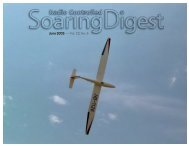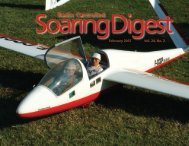4/03 RCSD - RC Soaring Digest - Rcsoaring.com
4/03 RCSD - RC Soaring Digest - Rcsoaring.com
4/03 RCSD - RC Soaring Digest - Rcsoaring.com
Create successful ePaper yourself
Turn your PDF publications into a flip-book with our unique Google optimized e-Paper software.
Path to Improvement<br />
in Thermal <strong>Soaring</strong><br />
Prepare a few strips of fine weave<br />
glass for the exterior repair. 1/2 oz. to<br />
3/4 oz. will do. Also cut up some peel<br />
ply that will be larger than the repaired<br />
area. If you’re going around a<br />
<strong>com</strong>pound curve, cut this into long<br />
strips that won’t wrinkle too much<br />
around the curve.<br />
Now mix up some microballoons in<br />
the West systems. Not so thick this<br />
time. Wet the area to be repaired (a<br />
solder brush works nicely), lay on the<br />
glass strips and then add the peel ply.<br />
When you put on the peel ply, tape<br />
one end of it to a good section of the<br />
fuselage and then pull it very tight<br />
across the resin/glass area. The strip<br />
needs to be long enough that you can<br />
then tape it down to a solid area of the<br />
fuselage on the other side of the<br />
damaged section.<br />
Repeat with each strip of peel ply until<br />
the entire area is covered. If you’ve<br />
pulled hard enough, two things<br />
happen:<br />
April 20<strong>03</strong><br />
By Bill Kuhl<br />
Bkuhl@luminet.net<br />
Introduction<br />
After my first year of sailplane<br />
flying, I thought I was a fairly<br />
<strong>com</strong>petent <strong>RC</strong> sailplane pilot. The<br />
second year of flying, my flying<br />
improved significantly also, in fact<br />
every year I seem to improve some.<br />
This made me realize this is a hobby<br />
that will provide continuous challenges.<br />
The first couple years, I often<br />
blamed the conditions for difficulty in<br />
thermalling, as my skills improved I<br />
found success staying up in lift in more<br />
conditions. With sailplane flying,<br />
fishing, and many other things, luck<br />
should be a decreasing factor in your<br />
success as you improve.<br />
The objective of this article is to discuss<br />
attitude and approach to improving<br />
thermal flying skills, not so much<br />
technical details covered in many other<br />
sources. It is about breaking down the<br />
elements and practicing smaller parts<br />
before trying to perfect everything at<br />
once. Hopefully I can offer a couple of<br />
tips that have helped me.<br />
In writing this article, I came up with<br />
several points that were important to<br />
me.<br />
Attitude<br />
Your success or failure has more to do<br />
with controllable factors than by luck,<br />
good or bad. Seemingly small factors<br />
added together can give big results.<br />
The skills will not be learned overnight;<br />
if they could be it would not be<br />
such a challenging, interesting hobby.<br />
Adjusting Your Attitude<br />
It is only natural to think that the small<br />
things really don’t matter, how could a<br />
slight difference in the curve of a wing<br />
1) You force the resin into the glass<br />
cloth, and<br />
2) The excess resin bleeds out through<br />
the peel ply.<br />
At this point, your repair looks RE-<br />
ALLY ugly. Have faith. Set it aside for<br />
24 hours, then <strong>com</strong>e back and pull off<br />
the peel ply. What’s left behind is a<br />
very well wet out repair with no excess<br />
resin and maybe a few small ridges<br />
that can be wet sanded out with very<br />
little effort (this is where the micro<br />
balloons really help).<br />
After wet sanding, hit it with primer to<br />
find any little pin holes and fill those.<br />
Prime and wet sand, then spray with<br />
the best color match you can find.<br />
For the tail boom of a glass fuselage,<br />
it’s even easier. At this point it’s hard<br />
to get to inside the boom so we’re<br />
working on the outside. Again, reassemble<br />
with CA and a sandable filler<br />
and be sure the alignment is REAL<br />
good.<br />
make a difference? In an activity that is<br />
so much about efficiency, all the little<br />
things together can make a huge<br />
difference. One of the biggest attitudes<br />
to over<strong>com</strong>e is that your skills don’t<br />
need improvement. Contest flying<br />
should prove to you that there is room<br />
for improvement.<br />
The fair weather attitude is one I<br />
admittedly have problems with,<br />
practicing only on days with light<br />
wind and plenty of sunshine, will not<br />
make you a <strong>com</strong>petent contest pilot.<br />
Besides, when you try to fly on the<br />
slope in 30 mph winds, it will be a<br />
traumatic experience when landing<br />
without some windy weather experience.<br />
If you have power plane experience,<br />
following thermals will take some<br />
change in your flight paths over the<br />
field. As Dave Thornburg stated,<br />
“Thermals don’t care about field<br />
boundaries, tree lines, and such.” In<br />
Thornburg’s video I thought he made<br />
it seem like thermals travel in a<br />
straight line downwind. Paul Naton in<br />
his “Secrets of Thermal Flying “ video<br />
showed graphics of how the path of a<br />
thermal downwind can take many<br />
(continued on page 16)<br />
Wet sand the fuselage to expose the<br />
glass all the way around. Then use the<br />
resin micro balloon mix to coat the<br />
repair surface. Lay down 2-3 layers of<br />
3/4 oz. cloth and then spiral wrap the<br />
boom with peel ply. Tape one end and<br />
pull it pretty hard across the repair<br />
area. Tape the other and then leave it<br />
alone for 24 hours.<br />
After the resin has cured, remove the<br />
peel ply. Most of the excess gunk goes<br />
with it. Sand and prime as before and<br />
you’ll wind up with a very strong<br />
repair with little, if any, visible signs of<br />
irregularities after you’re done.<br />
A couple of pictures of the break in the<br />
Omega boom are shown as an example.<br />
One round of primer and wet<br />
sanding was all it took to get back to<br />
near original quality.<br />
The Omega is back in the air again.<br />
Now if I could just fix that brain-glitch<br />
about which program to run with<br />
which planeÖÖ.<br />
<br />
Page 15
















